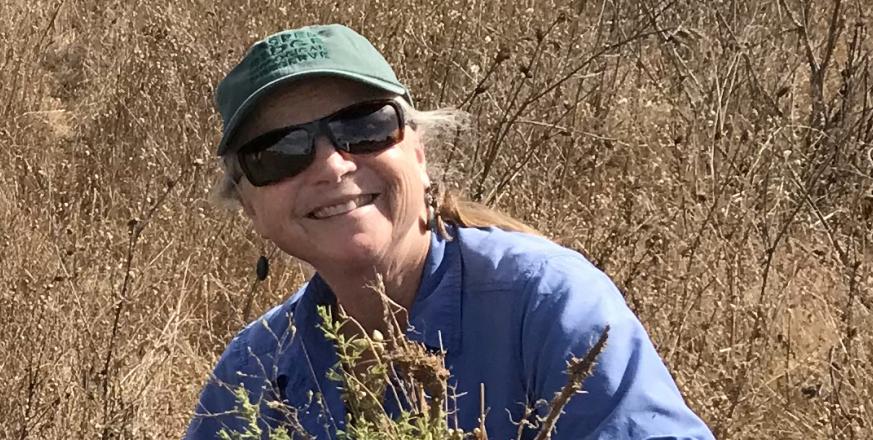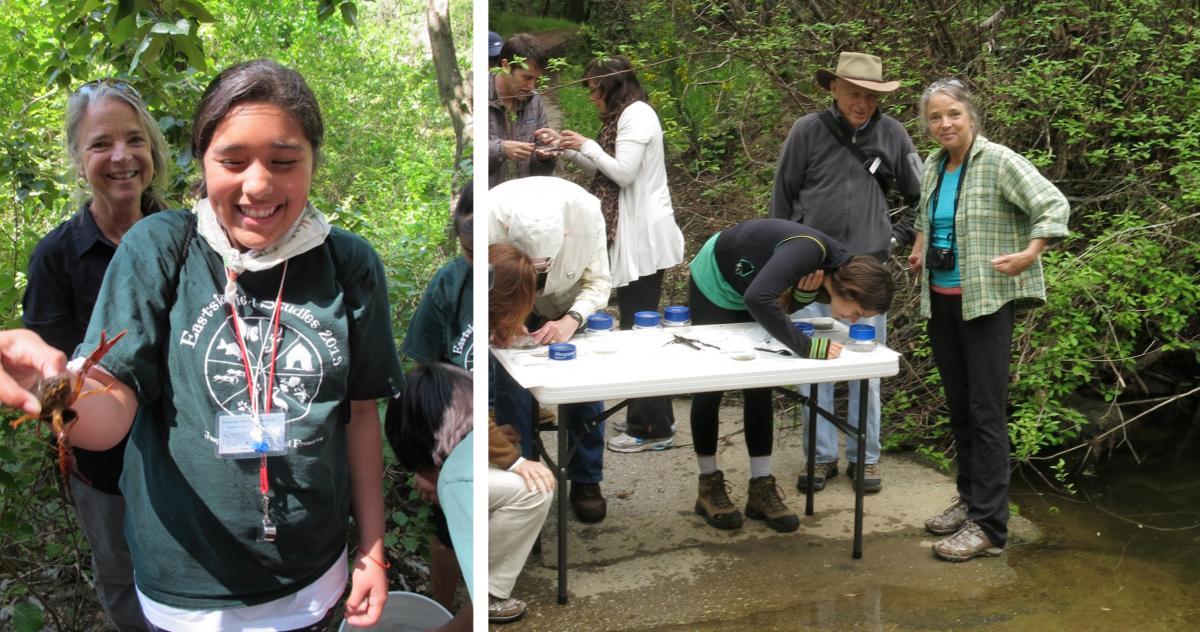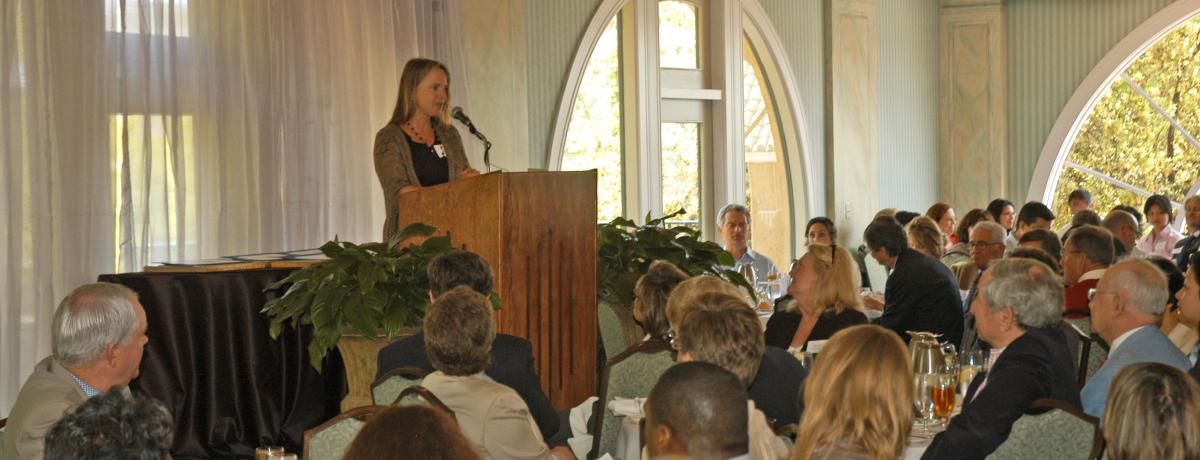Cindy Wilber is retiring from Stanford

JRBP education coordinator Cindy Wilber will retire from Stanford in June after a 21-year career at Jasper Ridge creating and administering educational programs that instill a love of outdoor learning, promote diversity in the field of ecology, and inspire students to give back through outreach education. Her dedicated teaching and mentoring have touched the lives of everyone at Jasper Ridge. In an evening lecture on May 21 at the Sun Field Station, Cindy will share the philosophy and goals that have guided her achievements and her plans for the future.
JRBP’s flagship course BIO/ESYS 105, Ecology and Natural History of Jasper Ridge Biological Preserve, reflects the philosophy and dedication of Cindy’s approach to education. In this demanding, two-quarter course, which always has more applicants than she can admit, Cindy honed a curriculum and teaching ethic that emphasizes hands-on discovery by a diverse and multigenerational class, often ranging in age from 18 to 80. The policies Cindy established in BIO/ESYS 105 have made it life-changing for many. Among those policies is that every session begins with the instructor sharing their personal career path. Students have credited this policy with helping them see that there are many routes to becoming a scientist, and instructors have credited it with helping them use their life experiences to stimulate dialog. Cindy’s mantra—“telling is not teaching”— has pushed instructors to dig deep, develop hands-on teaching methods, and revisit how they themselves got hooked on learning.
When Cindy joined the Jasper Ridge staff in 1998, she made it clear that improving minority representation in ecology and environmental science was of major importance to her. She followed through on that goal via the composition of BIO/ESYS 105, but also through many other programs, including some that leveraged the success and impact of BIO/ESYS 105. One example was the Jasper Ridge/Eastside Field Studies program, in which Stanford students from BIO/ESYS 105 taught and mentored Eastside College Prep sophomores, all minority students, in field science at Jasper Ridge. The curriculum and teaching methods were so successful that Cindy and her team were able to employ them, essentially unchanged, a few years later in a program for 6th graders—again, all minority students. This longterm program was a true partnership: for 6th grade students from communities underrepresented in science, it provided an opportunity to learn firsthand how to be field scientists; for Stanford students, it provided firsthand experiences as teachers.

Creekside teaching for students of all ages
Partnerships have been important throughout Cindy’s achievements, including partnerships with Stanford colleagues, especially Rodolfo Dirzo, and partnerships with programs. For example, Cindy initiated a partnership between Jasper Ridge and a continuation high school in Redwood City, forming the Redwood Environmental Academy of Leadership; she trained students and docents in bilingual teaching; she enlisted superstar minority scientists to serve as role models and mentors, and she sponsored a Stanford chapter of SEEDS (the Ecological Society of America’s program for “Diverse People for a Diverse Science”). Through partnerships with the Native American Cultural Center at Stanford, Cindy also honored and fostered the connection between Native American students and Jasper Ridge, encouraging, among other things, student projects on tribal knowledge of Jasper Ridge plants.
Another way in which Cindy expanded educational outreach was through teacher-training programs. Partnering with the Stanford Teacher Education Program (STEP) and the Teacher Institute on Science and Sustainability (TISS) operated by the California Academy of Sciences, Cindy hosted workshops to provide curriculum and training in field sciences for K-12 teachers. This acts as a large multiplier effect for outreach by Jasper Ridge, enriching the curriculum of schools across the San Francisco Bay area.

Cindy describing the award-winning Eastside Field Studies partnership program
Cindy’s commitment to opening up scientific careers to everyone also extends to her personal life. More than two decades ago, she founded Proyecto Itzaes, a non-profit that promotes literacy and science education in small, rural villages in the Yucatán. This has opened new opportunities for research and conservation partnerships with her Stanford colleagues and students. As one example, in 2017, Cindy organized a collaboration between the Coalition for the Public Understanding of Science (COPUS) and Proyecto Itzaes to hold the very first science fair in the village of Ixil, Yucatán, Mexico, part of her longterm effort to expand educational resources for rural Maya villages.
Cindy has made BIO/ESYS 105 the link among all these efforts—a gateway between learning and giving back. As students discover the power of hands-on learning, they practice those same teaching methods and mentoring techniques in outreach opportunities that Cindy created. These interlocking programs have created a network of support, contacts, and road maps helping students explore career paths in science and education. It has become a uniquely integrated and impactful educational experience.
In 2018 the School of Humanities and Sciences at Stanford recognized Cindy’s service with the Arnice P. Streit Service of Excellence Award. She was honored as an inspirational teacher, as a hero in diversifying the next generation of field scientists, as a coalition builder, and as a trusted mentor. To that we would add that Cindy has steadfastly advanced the principles that science is conducted by people of all colors and orientations, that teaching flows bidirectionally between the old and young, and that humans are an integral part of the natural environment. Her adherence to those principles and her dedication to hands-on learning have been transformative for the mission of Jasper Ridge and our capacity to contribute to that mission.
Gracias, Cindy!



